-
REVIEW07-29-2024
Utilization of local pressure devices in pain management during injections: scoping review
Revista Brasileira de Enfermagem. 2024;77(3):e20230399
Abstract
REVIEWUtilization of local pressure devices in pain management during injections: scoping review
Revista Brasileira de Enfermagem. 2024;77(3):e20230399
DOI 10.1590/0034-7167-2023-0399
Views0See moreABSTRACT
Objective:
to map scientific evidence regarding the use of local pressure devices in pain relief during injection procedures in patients.
Methods:
scoping review, following the recommendations of the JBI Manual for Evidence Synthesis and PRISMA-ScR, with searches conducted in the PubMed, EMBASE, CINAHL, LILACS, and PsycINFO databases, without temporal restrictions and with a cutoff date of March 2023.
Results:
a total of 1,514 studies were identified, with 20 articles included in the final sample. The ShotBlocker® device was utilized during subcutaneous and intramuscular injections in children and adults, proving beneficial in reducing pain, anxiety, and fear associated with the procedure.
Final considerations:
the ShotBlocker® is a low-cost, easy-to-use device that can enhance nursing clinical practice during painful procedures. However, studies involving the Brazilian Pikluc® device are scarce. Further research involving both local pressure devices is recommended.
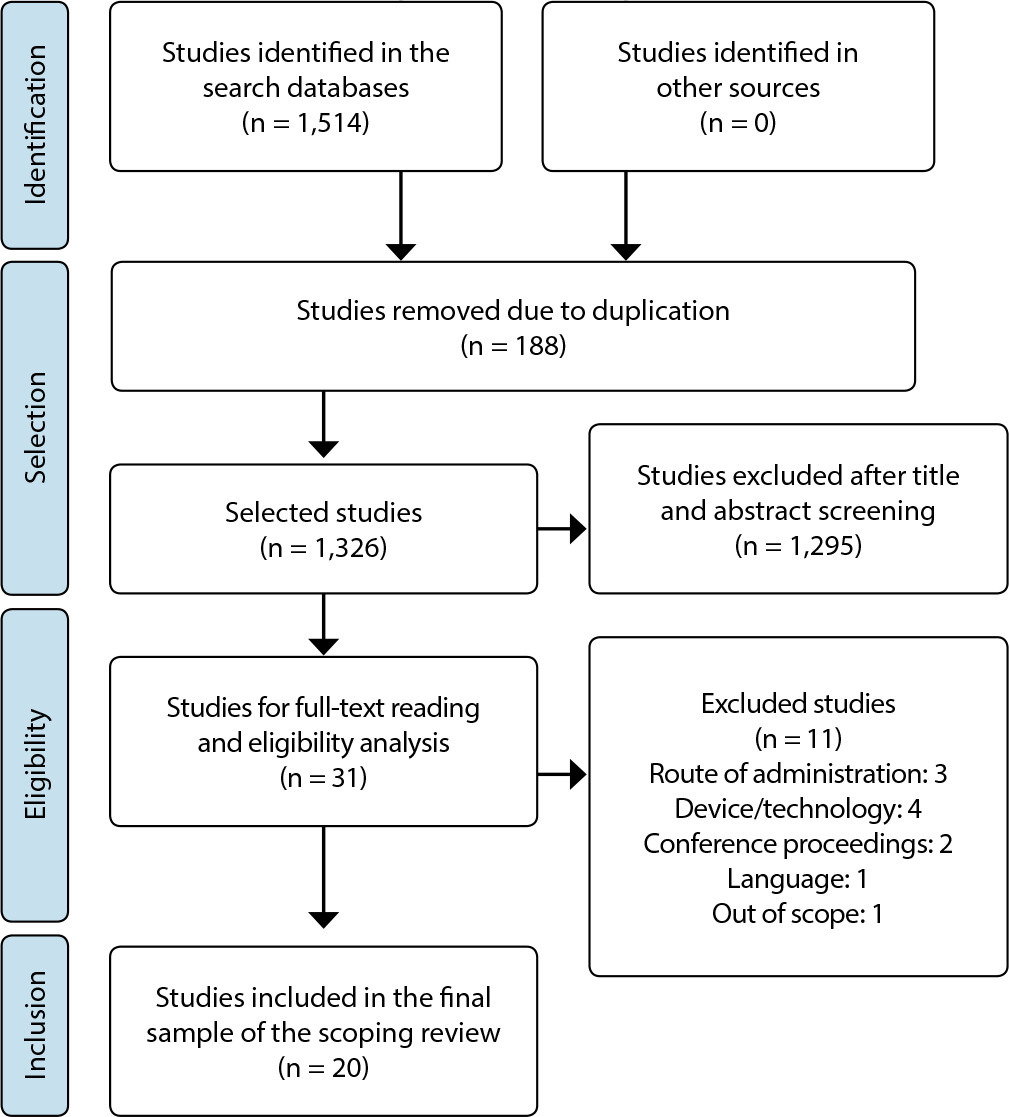
-
ORIGINAL ARTICLE07-29-2024
Sexual counseling for people with acute coronary syndrome: educational video development
Revista Brasileira de Enfermagem. 2024;77(3):e20230416
Abstract
ORIGINAL ARTICLESexual counseling for people with acute coronary syndrome: educational video development
Revista Brasileira de Enfermagem. 2024;77(3):e20230416
DOI 10.1590/0034-7167-2023-0416
Views0See moreABSTRACT
Objective:
to assess validity evidence of an educational video on safe sexual activity after acute coronary syndrome.
Method:
study in three phases: video development; content validity analysis by 11 experts; and analysis of validity based on response processes by seven people with coronary disease. The content validity ratio (CVR) was calculated with critical values for the second phase of 0.63 and for the third of 1.0.
Results:
the video addressed the importance of resuming sexual activity and positions that consume less energy, clinical warning signs, the importance of adhering to treatment and a welcoming environment for sexual practice. A CVR above the critical value was obtained with a total of 4 minutes and 41 seconds.
Conclusion:
the educational video brings together adequate content validity evidence and can be used as a tool for patients after acute coronary syndrome.
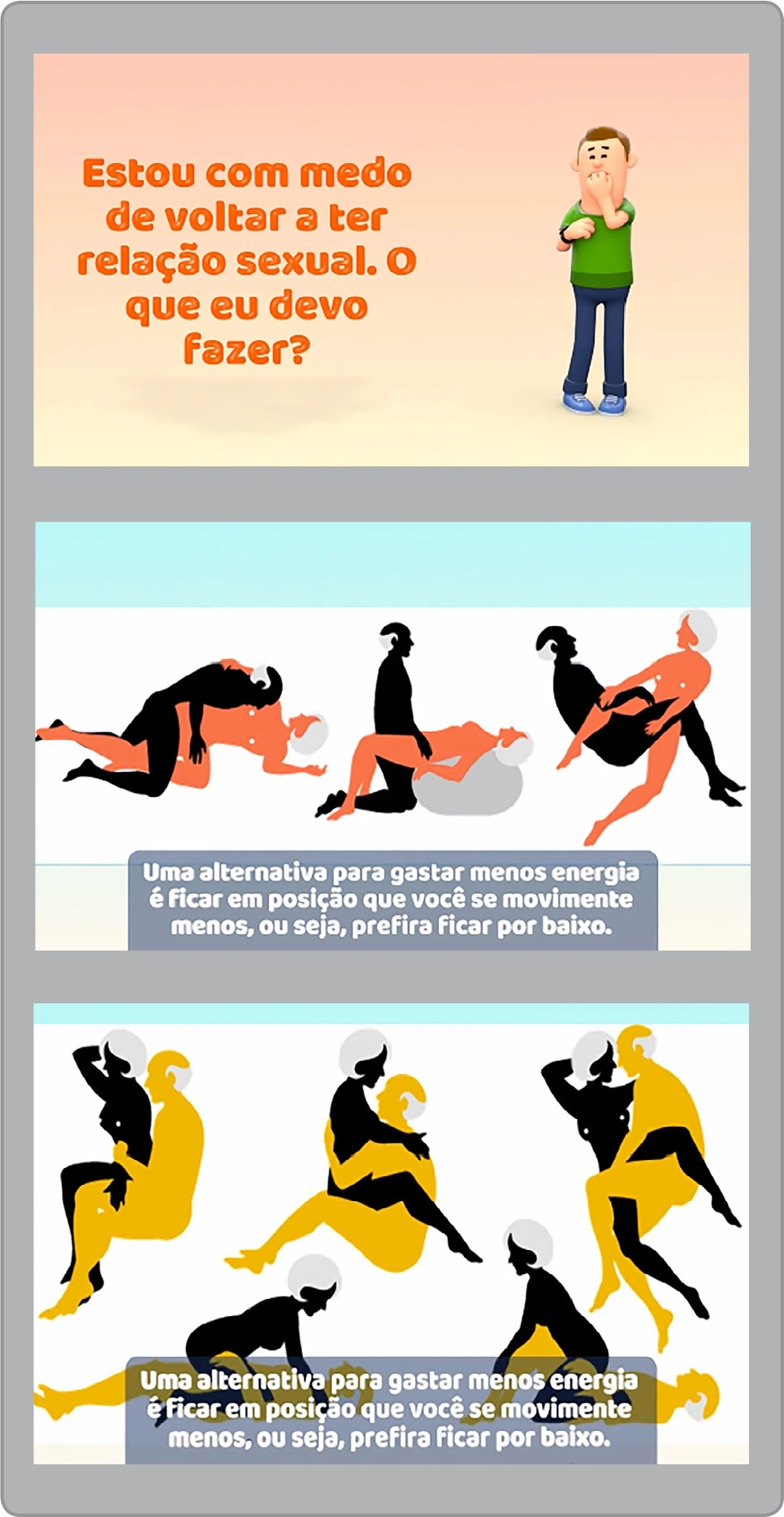
-
ORIGINAL ARTICLE07-19-2024
The use of spirituality/religiosity by oncology nurse residents in nursing care
Revista Brasileira de Enfermagem. 2024;77(2):e20230383
Abstract
ORIGINAL ARTICLEThe use of spirituality/religiosity by oncology nurse residents in nursing care
Revista Brasileira de Enfermagem. 2024;77(2):e20230383
DOI 10.1590/0034-7167-2023-0383
Views1See moreABSTRACT
Objectives:
to analyze the use of spirituality/religiosity by oncology nurse residents in caring for patients with cancer.
Methods:
a census, descriptive, sectional study, with 46 nurse residents from three public hospitals in Rio de Janeiro. Data collection took place between August 2020 and January 2021, using a sociodemographic questionnaire, including a question about the use of spirituality/ religiosity to deal with work situations. Descriptive analysis was carried out using SPSS software version 22.0.
Results:
participants stated that they use religiosity/spirituality in work situations related to patients or themselves. In relation to patients, death was the most mentioned situation among professionals, and for themselves, everyday situations and emotional vulnerability were the most mentioned.
Final Considerations:
spirituality and religiosity are dimensions that guide oncology nurse residents’ attitudes.
-
ORIGINAL ARTICLE07-19-2024
Translation and cross-cultural adaptation of the MISSCARE Survey-Ped into Brazilian Portuguese
Revista Brasileira de Enfermagem. 2024;77(2):e20230060
Abstract
ORIGINAL ARTICLETranslation and cross-cultural adaptation of the MISSCARE Survey-Ped into Brazilian Portuguese
Revista Brasileira de Enfermagem. 2024;77(2):e20230060
DOI 10.1590/0034-7167-2023-0060
Views0See moreABSTRACT
Objectives:
to translate and cross-culturally adapt the MISSCARE Survey-Ped for use in Brazil.
Methods:
a methodological study proposed by translation, synthesis of translations, back-translation, assessment by a committee of experts and pre-testing with the target population.
Results:
two direct translations of the instrument were carried out, followed by a consensual version between them. This synthetic version was back-translated and analyzed by a committee of five experts in pediatric nursing and patient safety, obtaining a Content Validity Index (CVI) of 0.95 and Cronbach’s alpha of 0.804. The final version was sent for pre-testing with 254 Brazilian pediatric nurses, with 44 (17.3%) analyzing the instrument for understanding (CVI 0.866; Content Validity Ratio (CVR) 0.773), relevance (CVI 0.931; CVR 0.864) and relevance (CVI 0.977; CVR 0.955).
Conclusions:
the MISSCARE Survey-Ped Brasil was considered suitable for application in pediatric nurses’ clinical practice in the country.
-
REVIEW07-19-2024
Drug-resistant tuberculosis: integrative review of nursing care in primary health care
Revista Brasileira de Enfermagem. 2024;77(2):e20230097
Abstract
REVIEWDrug-resistant tuberculosis: integrative review of nursing care in primary health care
Revista Brasileira de Enfermagem. 2024;77(2):e20230097
DOI 10.1590/0034-7167-2023-0097
Views0See moreABSTRACT
Objectives:
to identify, in the scientific literature, the care that should be provided to individuals with drug-resistant tuberculosis by nurses in primary health care.
Methods:
integrative review, using the Preferred Reporting Items for Systematic Reviews and Meta-Analyses study selection flowchart. Data collection was conducted in November 2022, across ten databases.
Results:
six studies emphasized that nurses should perform directly observed treatment; two highlighted the importance of integrated care management between tuberculosis and human immunodeficiency virus; two demonstrated comprehensive nursing consultation using the nursing process; one emphasized person-centered care, with discharge planning and improved hospital communication with primary health care services.
Final Considerations:
the care that nurses should provide to individuals with drug-resistant tuberculosis in primary health care, for care resolution, is evidence-based.
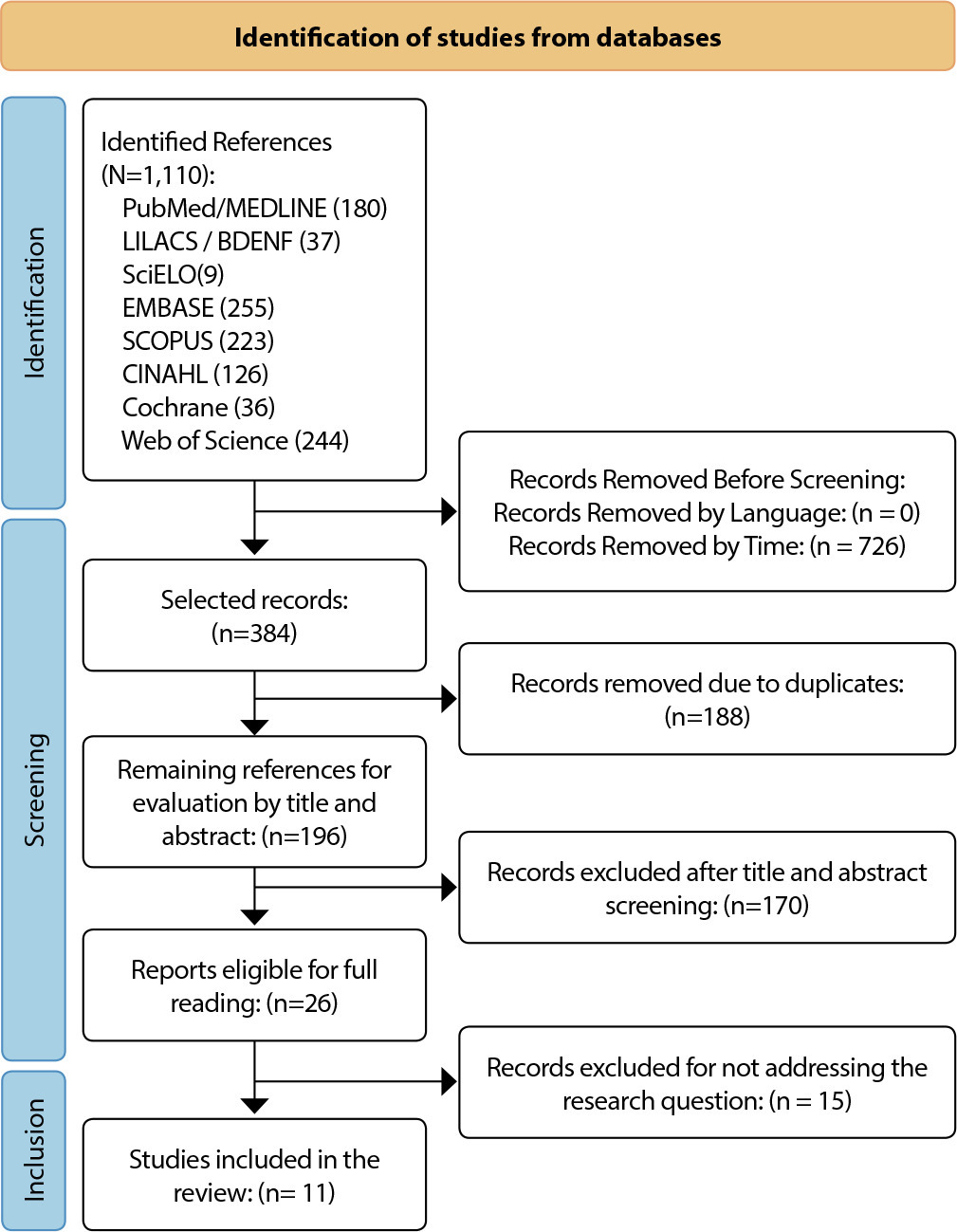
-
ORIGINAL ARTICLE07-19-2024
Understanding intimate self-care among riverine women: qualitative research through the lens of the Sunrise Model
Revista Brasileira de Enfermagem. 2024;77(2):e20230364
Abstract
ORIGINAL ARTICLEUnderstanding intimate self-care among riverine women: qualitative research through the lens of the Sunrise Model
Revista Brasileira de Enfermagem. 2024;77(2):e20230364
DOI 10.1590/0034-7167-2023-0364
Views0See moreABSTRACT
Objectives:
to contribute to the change in understandings and knowledge of the popular system among riverine women about female intimate self-care before and after the application of an educational dynamic.
Methods:
a qualitative-participative study based on the Sunrise Model. Twenty women registered at a Basic Health Unit on the Combu island, state of Pará, Brazil, participated in the second half of 2022. Semi-structured interviews were conducted before and after the educational dynamic; followed by reflective inductive analysis.
Results:
these are pointed out: a female mechanism of generational education; the cultural act of bathing as synonymous with intimate self care and disease prevention; intimate care with medicinal herbs; lack of professional system approach to the topic; fear of using “muddy water”; and lack of financial resources to purchase specific products for genitourinary care.
Final Considerations:
companionship and social factors drive intimate self-care; however, riverine women experience taboos, ignorance, and poverty.
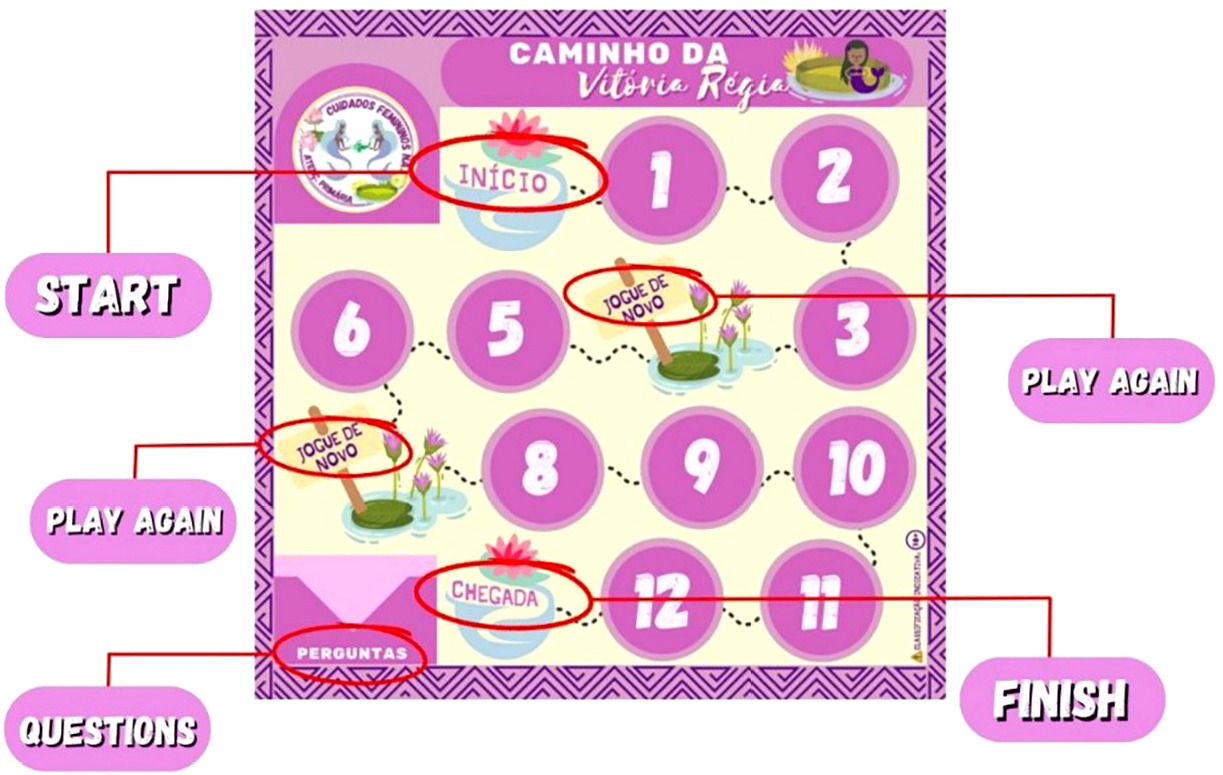
-
ORIGINAL ARTICLE07-19-2024
Validation of an instrument for assessing leprosy care in children and adolescents
Revista Brasileira de Enfermagem. 2024;77(2):e20230344
Abstract
ORIGINAL ARTICLEValidation of an instrument for assessing leprosy care in children and adolescents
Revista Brasileira de Enfermagem. 2024;77(2):e20230344
DOI 10.1590/0034-7167-2023-0344
Views1See moreABSTRACT
Objectives:
to validate the content of an instrument for assessing leprosy care in individuals under 15 years old in the context of Primary Health Care.
Methods:
methodological study of content validation, based on the evaluation of essential and derived attributes in primary care, in the professional version. For data analysis, the Content Validation Index (CVI ≥ 0.8) and Cronbach’s Alpha were calculated.
Results:
a higher percentage of judges among nurses (61.5%) was observed; with a doctorate (46.2%), and engaged in teaching and research (77%). The overall Content Validation Index of the instrument was 0.98. In the analysis of Cronbach’s Alpha of the instrument, the assigned value was 0.717.
Conclusions:
the instrument represents an advancement in the measurement of health evaluation policies and can significantly contribute to improving the quality of care provided to children and adolescents with leprosy.
-
ORIGINAL ARTICLE07-19-2024
Validation of an instrument for patient classification to support obstetric nursing care
Revista Brasileira de Enfermagem. 2024;77(2):e20230401
Abstract
ORIGINAL ARTICLEValidation of an instrument for patient classification to support obstetric nursing care
Revista Brasileira de Enfermagem. 2024;77(2):e20230401
DOI 10.1590/0034-7167-2023-0401
Views0See moreABSTRACT
Objectives:
to develop and validate an instrument for the classification of pregnant and postpartum women according to the demand for nursing care.
Methods:
a methodological study conducted in three stages: 1) construction of the instrument based on literature review; 2) content validation using the Delphi technique with 12 experts; and 3) Evaluation of the convergent construct validity through the correlation between the scores of the constructed instrument and the Fugulin instrument.
Results:
an instrument with ten indicators of specific care for pregnant and postpartum women was developed. A content validity index higher than 0.9 was obtained, requiring only one round of the Delphi technique. The Spearman coefficient was 0.64 between the instruments, indicating a strong correlation.
Conclusions:
the classification instrument specifically constructed for pregnant and postpartum women showed evidence of content validity and convergent construct validity with a widely used instrument in the national territory.
-
REVIEW06-10-2022
Self-inflicted violence and suicide in people living with HIV/AIDS: a systematic review
Revista Brasileira de Enfermagem. 2022;75:e20210768
Abstract
REVIEWSelf-inflicted violence and suicide in people living with HIV/AIDS: a systematic review
Revista Brasileira de Enfermagem. 2022;75:e20210768
DOI 10.1590/0034-7167-2021-0768
Views0See moreABSTRACT
Objectives:
to analyze intellectual productions on self-inflicted violence and suicide in people living with HIV/AIDS.
Methods:
a systematic review, carried out between March and April 2021, in the PubMed®/MEDLINE®, Web of Science and LILACS databases, subsidized in the Strengthening the Reporting of Observational Studies in Epidemiology. The period outlined was from 2011 to 2020.
Results:
a total of 199 studies were identified, and 16 composed the final sample, grouped into the categories: Sociodemographic characteristics of victims of self-inflicted violence/suicide and their intervening factors (pointing to young adults, especially homosexuals, with low social support and a history of mental illness or substance abuse as usual victims); Successful measures for suicide prevention/control in people living with HIV/AIDS (suggesting more frequent psychosocial and clinical follow-up of those starting antiretroviral and immunocompromised treatment).
Conclusions:
biopsychosocial follow-up, analysis of sociodemographic profile and intervening factors should be frequent in this population for disease prevention/control.

-
ORIGINAL ARTICLE09-05-2022
Screening for common mental disorder in elderly residents in the countryside: a cross-sectional study
Revista Brasileira de Enfermagem. 2022;75:e20210875
Abstract
ORIGINAL ARTICLEScreening for common mental disorder in elderly residents in the countryside: a cross-sectional study
Revista Brasileira de Enfermagem. 2022;75:e20210875
DOI 10.1590/0034-7167-2021-0875
Views0See moreABSTRACT
Objective:
To estimate the prevalence of common mental disorders and their associated factors in the elderly in a municipality in the countryside of the Brazilian Midwest.
Methods:
Quantitative, observational, cross-sectional approach research, conducted with 218 elderly people.
Results:
The prevalence of the common mental disorder among the elderly was 25.1%; in the univariate analysis, it was higher in females (35.4%), in the age group of 80 years or older (46.1%), brown skin color (30.2%), widowed (42.6%), illiterate (47.6%), and retired (27.6%). In the multiple analysis, the variables female gender (p<0.006), age 80 years or older (p<0.036), dissatisfaction with life (p<0.009), lack of social interaction (p=0.017), and dysfunctional family (p=0.021) remained associated with CMD.
Conclusion:
The results revealed are helpful and contribute to the reinforcement of the need for mental health care in this population extract so growing worldwide.
-
ORIGINAL ARTICLE06-03-2022
Association between falls in older adults and prevention group
Revista Brasileira de Enfermagem. 2022;75:e20200207
Abstract
ORIGINAL ARTICLEAssociation between falls in older adults and prevention group
Revista Brasileira de Enfermagem. 2022;75:e20200207
DOI 10.1590/0034-7167-2020-0207
Views0See moreABSTRACT
Objectives:
to assess the effectiveness of guidelines on fall prevention in a group of older adults in Primary Health Care.
Methods:
a cross-sectional study, carried out with older adults selected by a simple random sample (274; N=1,234). Data covered sociodemographic and socioeconomic variables, marital status, health conditions, factors associated with falls and participation in the prevention group. Student’s t test was used, and dichotomous variables were used by the chi-square test. The project met ethical requirements.
Results:
sample with female profile (61.7%), married, with low education, mean age of 71.69 years. The factors associated with falls identified were female sex, medicalization and participation in the prevention group. There was no protective association between participation in a fall prevention group in older adults and a decrease in the number of falls.
Conclusions:
based on evidence, a personalized intervention during the nursing visit is suggested as a strategy to prevent falls.

-
ORIGINAL ARTICLE03-07-2022
Predictors of frailty in older people users of Primary Health Care
Revista Brasileira de Enfermagem. 2022;75:e20201292
Abstract
ORIGINAL ARTICLEPredictors of frailty in older people users of Primary Health Care
Revista Brasileira de Enfermagem. 2022;75:e20201292
DOI 10.1590/0034-7167-2020-1292
Views0See moreABSTRACT
Objective:
to identify the prevalence and predictors of frailty in older people in Primary Health Care.
Method:
this is a descriptive and correlational study, carried out in a convenience sample of 136 older people in the community. Data were collected through a sociodemographic and clinical questionnaire and frailty phenotype. Student’s t test or U-Mann-Whitney test, chi-square and binary logistic regression were used for data analysis.
Results:
the prevalence of frailty was 26.5% (n=36). Frail individuals had older age (p=0.011), worse self-rated health (p=0.001) and lower physical capacity (p<0.001). In the multivariable regression, it was observed that frail individuals had older age (Odds Ratio=1.111; 95% confidence interval=1.026-1.203) and worse physical capacity (Odds Ratio=0.673; 95% confidence interval=0.508-0.893).
Conclusions:
the prevalence of frailty in older people in Primary Health Care was considerable. Advanced age and worse physical capacity were the most relevant predictors of frailty in the elderly.
-
ORIGINAL ARTICLE04-15-2022
Validation of Questionnaire to Assess the Impact of Dementia on the Family
Revista Brasileira de Enfermagem. 2022;75:e20210232
Abstract
ORIGINAL ARTICLEValidation of Questionnaire to Assess the Impact of Dementia on the Family
Revista Brasileira de Enfermagem. 2022;75:e20210232
DOI 10.1590/0034-7167-2021-0232
Views0See moreABSTRACT
Objective:
To validate a questionnaire to assess the impact of dementia on one of the household members.
Methods:
Methodological study. The instrument was designed based on literature review, expert opinion, and researchers’ experience and then applied to a non-probability convenience sample consisting of 262 family members who live daily with a person with dementia. The construct validity was studied by exploratory factor analysis, principal components method, with varimax rotation of the items.
Results:
An instrument with 30 items was obtained, distributed in four dimensions: “Emotional dimension,” “Economic dimension,” “Family relations dimension,” and “Support-seeking dimension.” Factor analysis revealed a total explained variance of 54.96% and a total Cronbach’s alpha of .899.
Conclusions:
The instrument presents high internal consistency, grouped into four dimensions, all closely related to the family’s adaptation to the onset of dementia in one of its members.
-
ORIGINAL ARTICLE03-07-2022
Is self-esteem associated with the elderly person’s quality of life?
Revista Brasileira de Enfermagem. 2022;75:e20210388
Abstract
ORIGINAL ARTICLEIs self-esteem associated with the elderly person’s quality of life?
Revista Brasileira de Enfermagem. 2022;75:e20210388
DOI 10.1590/0034-7167-2021-0388
Views0See moreABSTRACT
Objective:
To analyze the association between self-esteem and quality of life in the elderly.
Methods:
Cross-sectional web survey developed with 519 elderly people. Participants filled out three data collection instruments developed on the Google Forms platform and widely disseminated through all of Brazil. Fisher’s exact test, Mann-Whitney, Pearson correlation, and linear regression with 95% confidence interval were used.
Results:
Self-esteem was associated with all quality-of-life facets: sensory skills [β= 1.307; p<0.001]; autonomy [β= 2.101; p<0.001]; past, present, and future activities [β= 2.486; p<0.001]; social presence [β= 2.547; p<0.001]; death and dying [β= 2.175; p<0.001]; and intimacy [β=2.378; p<0.001].
Conclusion:
There is a positive and statistically significant association between self-esteem and quality of life in the elderly. We therefore suggest the development of local policies capable of raising this age groups’ self-esteem and reaffirming aging as a new possibility for discoveries and pleasure.
-
EXPERIENCE REPORT10-24-2022
Nursing process for elderly women susceptible to falls from the perspective of the Pender’s Model
Revista Brasileira de Enfermagem. 2022;75:e20210913
Abstract
EXPERIENCE REPORTNursing process for elderly women susceptible to falls from the perspective of the Pender’s Model
Revista Brasileira de Enfermagem. 2022;75:e20210913
DOI 10.1590/0034-7167-2021-0913
Views0See moreABSTRACT
Objectives:
to describe the strategy of applying the nursing process guided by Pender’s Health Promotion Model to elderly women susceptible to falls with a view to promoting a self-efficacy behavior for fall prevention.
Methods:
application of the nursing process to eleven elderly women who had already experienced falls, living in a neighborhood in the outskirts of Belem, state of Pará, which involved interviews to obtain their nursing history and group meetings using the focus group technique to develop the other phases of the nursing process: nursing diagnosis, nursing interventions, and nursing assessment.
Results:
despite the risk factors for falls, the intervention model adopted in this study allowed elderly women to enhance their self-efficacy.
Final Considerations:
the model proved to be suitable for the participation of elderly women in actions to build fall prevention behaviors, with a view to healthier lifestyles.

-
ORIGINAL ARTICLE10-24-2022
Factors associated with symptoms of physical and emotional burden in informal caregivers of the elderly
Revista Brasileira de Enfermagem. 2022;75:e20210927
Abstract
ORIGINAL ARTICLEFactors associated with symptoms of physical and emotional burden in informal caregivers of the elderly
Revista Brasileira de Enfermagem. 2022;75:e20210927
DOI 10.1590/0034-7167-2021-0927
Views1See moreABSTRACT
Objectives:
to analyze the personal and work-related burden factors associated with physical and emotional symptoms of informal caregivers of the elderly.
Methods:
cross-sectional study conducted with 121 informal caregivers and 121 seniors who received care, assessed individually for the risk of: physical overload, musculoskeletal symptoms, Self-Reporting Questionnaire, effort perception, and Katz index.
Results:
a greater perception of effort raises up to 3.3 times the chances of presenting symptoms of pain in the spine region (p=0.01), and lower functional capacity of the elderly increases up to 1.3 times the chances of presenting pain symptoms in the spine region (p=0.02). The symptoms of emotional overload were associated with the caregiver’s low income (p=0.02).
Conclusions:
the perception of effort, dependence of the elderly, caregiver’s age, and symptoms of emotional overload are involved with caregivers’ symptoms of physical overload, and low income, with emotional overload.
-
ORIGINAL ARTICLE05-28-2021
Cultural adaptation and validation of an instrument about nursing critical thinking skills
Revista Brasileira de Enfermagem. 2021;74(2):e20200720
Abstract
ORIGINAL ARTICLECultural adaptation and validation of an instrument about nursing critical thinking skills
Revista Brasileira de Enfermagem. 2021;74(2):e20200720
DOI 10.1590/0034-7167-2020-0720
Views1See moreABSTRACT
Objectives:
to validate the Nursing Critical Thinking in Clinical Practice Questionnaire regarding cultural aspects and metric properties.
Methods:
a methodological research carried out through cross-cultural adaptation, face and content validity, dimensional construct and known groups validity, test-retest reliability and internal consistency. 511 nurses from four hospitals participated in the study, of which 54 participated in retest.
Results:
the instrument validation for Brazilian Portuguese maintained equivalences, according to the original version. The dimensional validity demonstrated adjustment to the tetrafactorial structure of the original version (GFI=0.69). There were statistically significant differences in critical thinking skills between nurses with graduate degrees and who undertook training, reading articles, developing research and working in an institution with a longer time implementation of the Nursing Process. The instrument showed temporal stability (ICC 073-0.84; p<0.001) and adequate internal consistency (α=0.97).
Conclusions:
the instrument proved to be valid and reliable for the studied population.
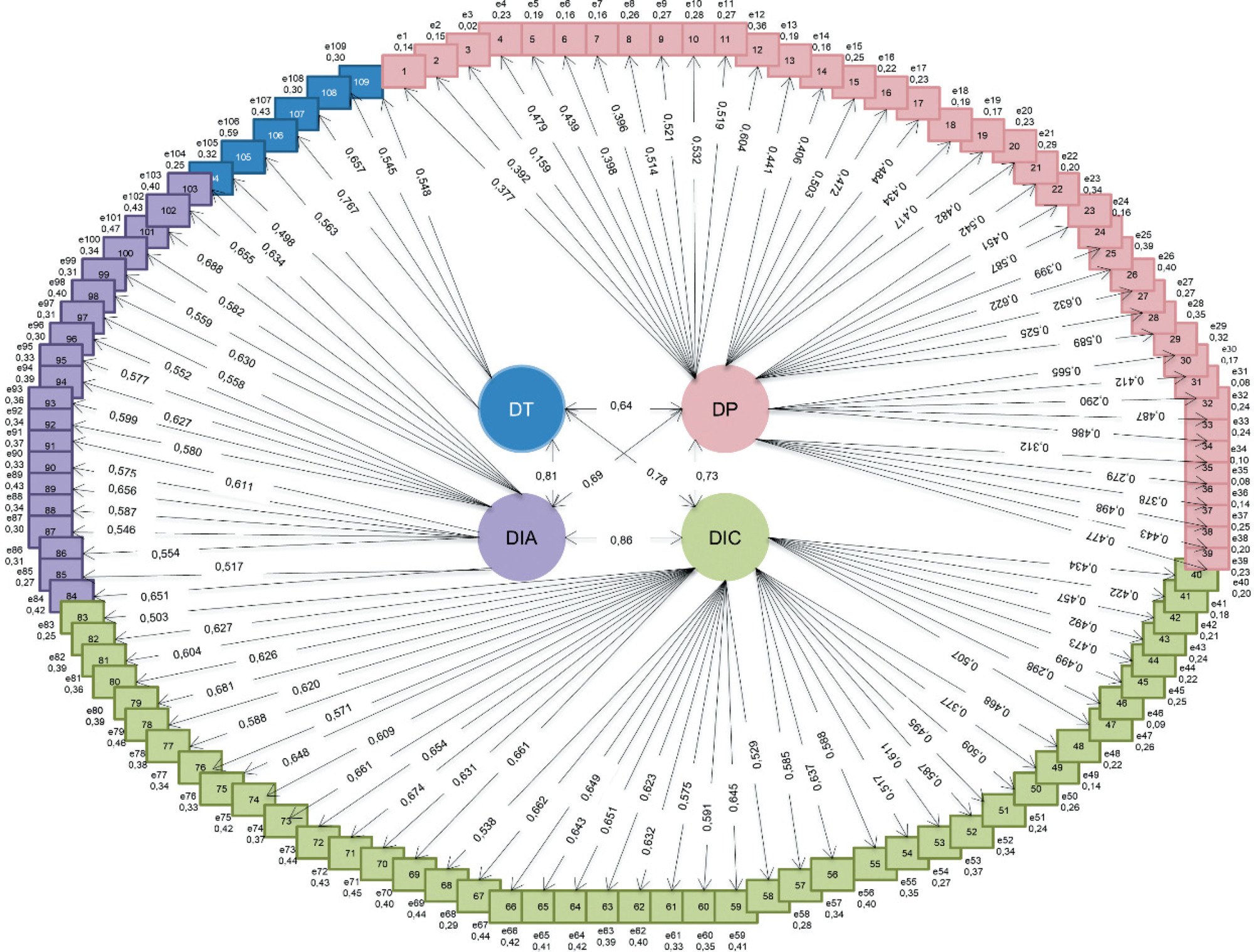
-
ORIGINAL ARTICLE07-30-2021
Curricular reforms in the transformation of nursing teaching in a federal university
Revista Brasileira de Enfermagem. 2021;74(4):e20201242
Abstract
ORIGINAL ARTICLECurricular reforms in the transformation of nursing teaching in a federal university
Revista Brasileira de Enfermagem. 2021;74(4):e20201242
DOI 10.1590/0034-7167-2020-1242
Views1See moreABSTRACT
Objectives:
to discuss the curricular reforms adopted for nursing teaching in Brazil, from 1969 to 2019.
Methods:
historical, qualitative approach using the thematic oral history and document research. 13 interviews were carried out with graduation nursing professors from a federal university in the South of Brazil. The document sources were the political-pedagogical projects of the course and their associated documents. Minayo’s thematic analysis was used.
Results:
nursing curricula delineates the profile of the professional that must be formed and are reviewed in order to be adapted to social and educational changes, showing the scientific and professional potential of the nurse. Curricular reforms consider the quality of nursing formation.
Final Considerations:
the structure of the curriculum and the reforms that took place emerged according to the historical, political, epidemiological and social context demanded from the profession, to attend to the demands of society and to the work market.
-
ORIGINAL ARTICLE06-11-2021
Social, health, and working conditions among hospital workers
Revista Brasileira de Enfermagem. 2021;74(2):e20200321
Abstract
ORIGINAL ARTICLESocial, health, and working conditions among hospital workers
Revista Brasileira de Enfermagem. 2021;74(2):e20200321
DOI 10.1590/0034-7167-2020-0321
Views0See moreABSTRACT
Objectives:
to compare social, health and working conditions among nursing, nutrition and hospital cleaning service workers.
Methods:
a quantitative cross-sectional, descriptive and correlational study carried out in a public hospital in the countryside of São Paulo, including workers from nutrition, cleaning and nursing services. Data collection occurred during working hours. Validated questionnaires and Karasek’s Demand-Control model were used to assess psychosocial dimensions and the Self-Reporting Questionnaire-20 to measure the common mental disorder. As dependent variable, the groups professionals and chi-square test were used for associations with p≥ 0.05.
Results:
227 workers participated. Positive associations were found between professional groups and socioeconomic, health and work characteristics.
Conclusions:
social, health, and working conditions differ between the professional groups studied.
-
ORIGINAL ARTICLE04-15-2022
Analysis of the temporal trend of mortality from sickle cell anemia in Brazil
Revista Brasileira de Enfermagem. 2022;75(4):e20210640
Abstract
ORIGINAL ARTICLEAnalysis of the temporal trend of mortality from sickle cell anemia in Brazil
Revista Brasileira de Enfermagem. 2022;75(4):e20210640
DOI 10.1590/0034-7167-2021-0640
Views0See moreABSTRACT
Objectives:
To analyze the temporal trend of mortality from sickle cell anemia in Brazil, by region, in the period 1997-2017.
Methods:
epidemiological study, with an ecological design, with a temporal trend, carried out with data from the Mortality Information System. For descriptive analysis, absolute and relative frequencies were used. In the correlation analysis, the ANOVA test was used, followed by Tukey’s post-test. The temporal trend was obtained using the cubic polynomial regression test.
Results:
6,813 deaths from sickle cell anemia were registered. Brown individuals (50.87%) were more frequent, with a predominance of males (50.4%), aged between 25 and 34 years and a higher incidence of deaths in the Midwest (0.25/100 thousand inhabitants). The time curve showed an increasing trend of deaths in the country between 1997 and 2015 (R2 = 0.98).
Conclusions:
sickle cell anemia showed increasing mortality in the 21 years analyzed and alerts health professionals and managers.
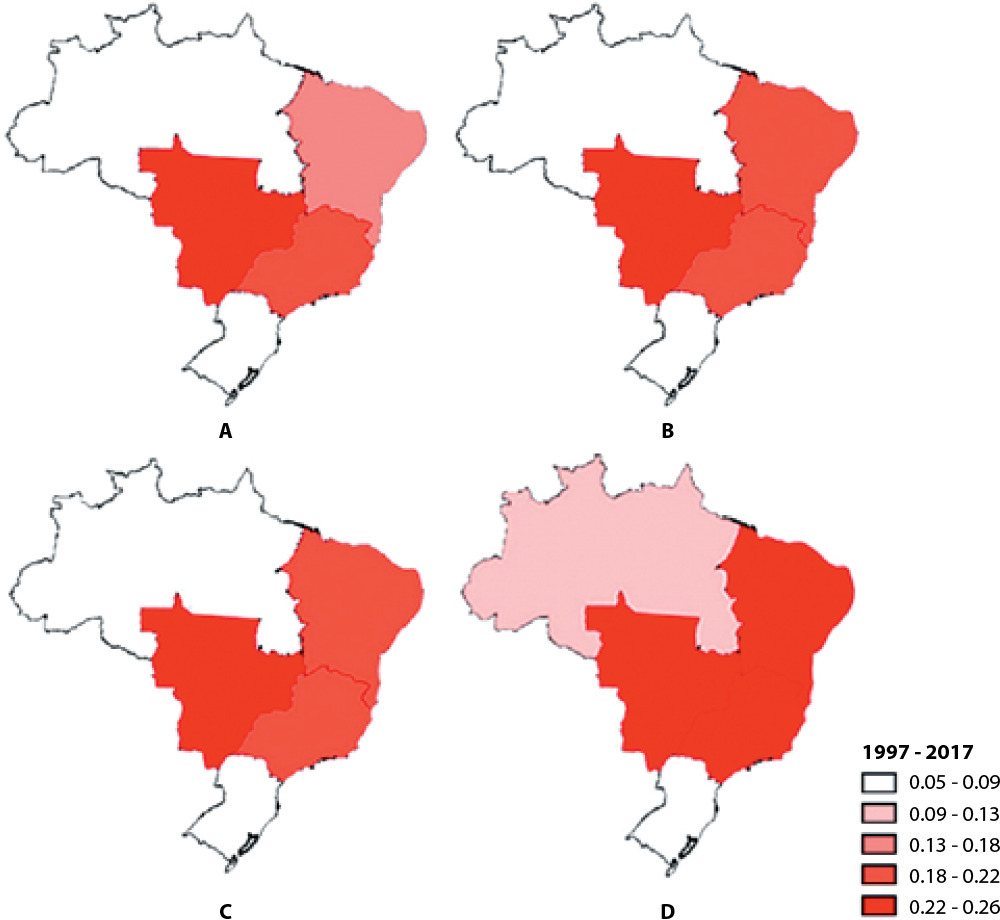
-
ORIGINAL ARTICLE09-29-2022
Construction and validation of an instrument for classifying nipple and areola complex lesions resulting from breastfeeding
Revista Brasileira de Enfermagem. 2022;75(1):e20210051
Abstract
ORIGINAL ARTICLEConstruction and validation of an instrument for classifying nipple and areola complex lesions resulting from breastfeeding
Revista Brasileira de Enfermagem. 2022;75(1):e20210051
DOI 10.1590/0034-7167-2021-0051
Views0See moreABSTRACT
Objectives:
to construct and validate a classification of nipple and areola complex lesions resulting from breastfeeding, according to content and appearance.
Methods:
this is a methodological study, developed in four stages: operational definition, instrument construction, content and appearance validation. The Delphi technique and a Likert-type scale were used to validate content and appearance, through the participation of ten and sixteen judges, respectively. For analysis, Content Validity Index and Kappa Coefficient were applied.
Results:
Content Validity Index obtained an overall value of 0.93 and, for appearance, 0.94. Kappa values ranged between 0.46 and 1. The high rates of agreement among judges demonstrated the quality of the proposed content validity.
Conclusions:
the Nipple and Areola Complex Lesions Classification Instrument developed obtained acceptable values of its indexes, proving to be valid in terms of content and appearance.
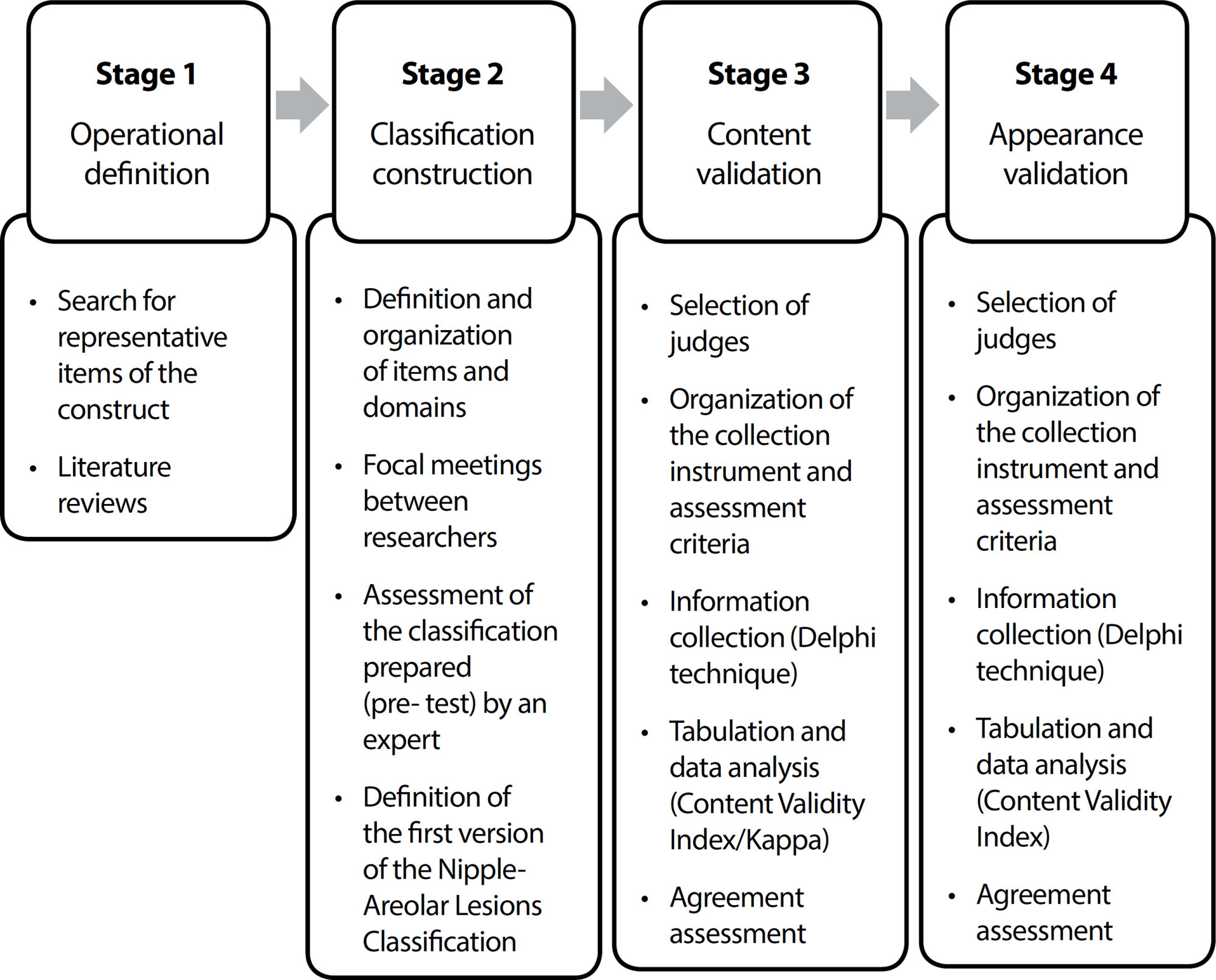
-
ORIGINAL ARTICLE09-24-2022
Patient safety in nursing technician training
Revista Brasileira de Enfermagem. 2022;75(1):e20201364
Abstract
ORIGINAL ARTICLEPatient safety in nursing technician training
Revista Brasileira de Enfermagem. 2022;75(1):e20201364
DOI 10.1590/0034-7167-2020-1364
Views0See moreABSTRACT
Objectives:
to analyze the contents on patient safety in the training of nursing technicians.
Methods:
a documentary study, conducted in three technical nursing courses at a public university in northeastern Brazil, based on the Multi-Professional Patient Safety Curriculum Guide, published by the World Health Organization.
Results:
we found that, of the 26 subjects in each course, the tracking terms were found in 22 subjects in the A/C courses, 23 in the B course. The topics of the guide with the highest number of terms were the improvement in medication safety, with 85 terms (22.6%), and Infection prevention and control, with 75 terms (20%). The contents do not express the comprehensiveness of patient safety education; some subjects had this focus, while others did not.
Conclusions:
the documents revealed gaps in the contents related to patient safety and demonstrated that they are addressed only in the course syllabus and discipline plans.
-
ORIGINAL ARTICLE03-24-2021
Content and usability validation of the Retire with Health web software
Revista Brasileira de Enfermagem. 2021;74(1):e20200133
Abstract
ORIGINAL ARTICLEContent and usability validation of the Retire with Health web software
Revista Brasileira de Enfermagem. 2021;74(1):e20200133
DOI 10.1590/0034-7167-2020-0133
Views0See moreABSTRACT
Objectives:
to validate the content and usability of the Retire with Health web software.
Methods:
a methodological study. The content validation was carried out by seven experts in the aging subject, using an instrument that evaluated the objectives, contents, relevance, and the environment of the web software. Usability was validated by seven experts in software development, referring to ergonomics, functionality, usability, and efficiency. The data were submitted to statistical analysis, described by calculating the Content Validity Index.
Results:
the global Content Validity Index found 0.97 for the usability aspects and 1.00 for the content. After incorporating all the experts’ suggestions, the Retire with Health web software was made available on the internet (www.aposentarsecomsaude.com.br).
Conclusions:
content validation and usability showed that the web software meets the objective of supporting reflection on retirement, with a high level of agreement among experts.
-
ORIGINAL ARTICLE09-06-2022
Evaluation of the health level of the elderly: patient care team considerations
Revista Brasileira de Enfermagem. 2022;75(1):e20201277
Abstract
ORIGINAL ARTICLEEvaluation of the health level of the elderly: patient care team considerations
Revista Brasileira de Enfermagem. 2022;75(1):e20201277
DOI 10.1590/0034-7167-2020-1277
Views0See moreABSTRACT
Objective:
To understand the differences of physicians, nurses, and social workers in the evaluation of the health status of the elderly.
Methods:
A cross-sectional quantitative study, using descriptive statistics. Non-probabilistic sample, consisting of 291 participants from three professional categories: 71 (24.4%) physicians, 192 (66%) nurses, and 28 (9.6%) social workers. We used a questionnaire including the variables: sociodemographic characteristics and instruments used for evaluation.
Results:
Instruments with greater utility for the evaluation of the elderly: for physicians, Mini Mental State Examination; for nurses, Braden scale; and for social workers, genogram. In the physical examination, the data most collected by physicians and nurses are the vital signs; and by social workers, the condition for performing the Activities of Daily Living.
Conclusions:
The evaluation of the elderly is based on a diversity of instruments and is an area in which health and social professionals need to share information.
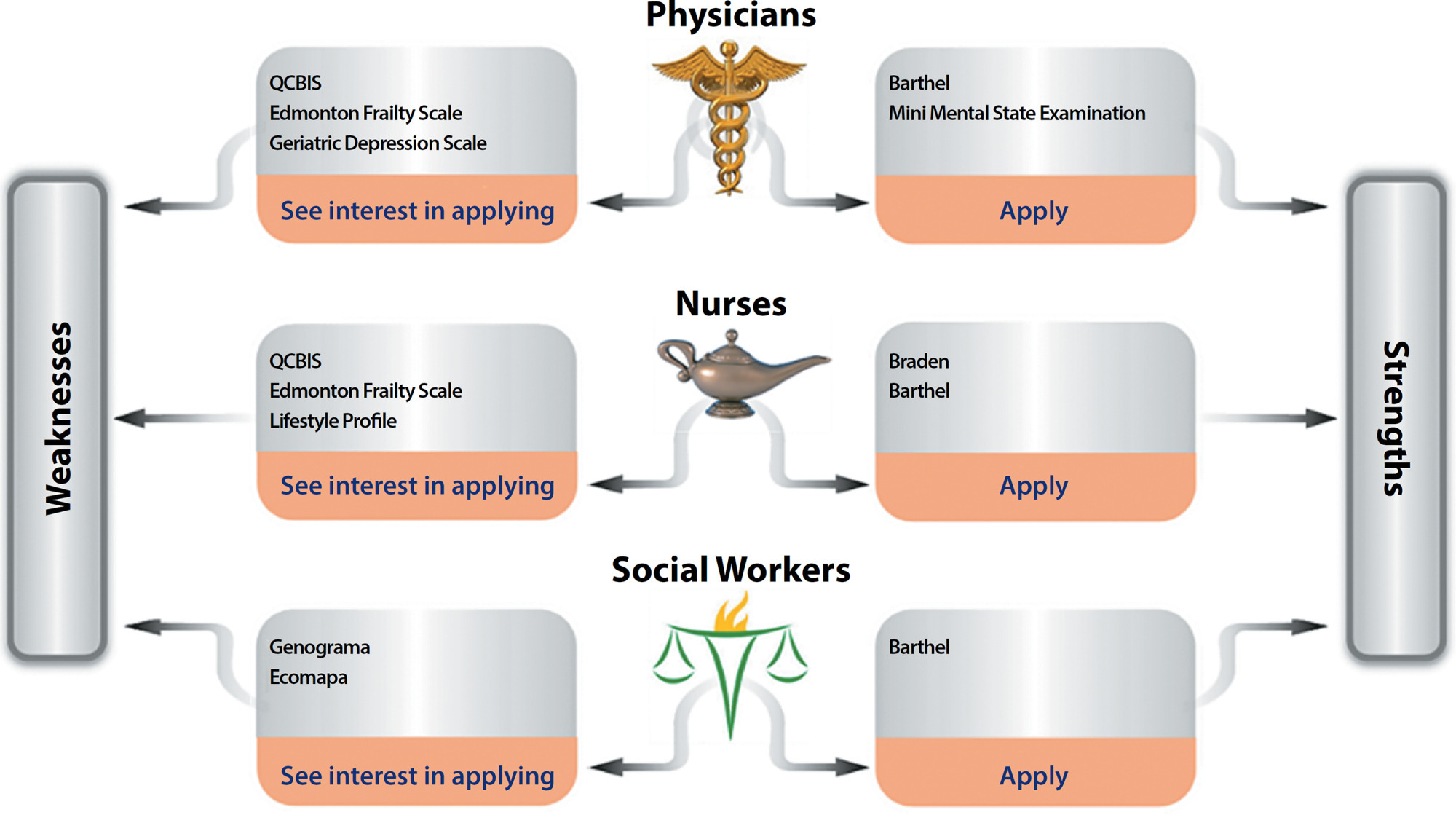
Search
Search in:
Nuvem de Tags
Adolescente (85) Atenção Primária à Saúde (239) COVID-19 (91) Criança (91) Cuidados de Enfermagem (269) Educação em Enfermagem (151) Educação em Saúde (139) Enfermagem (930) Enfermagem Pediátrica (86) Estudantes de Enfermagem (77) Estudos de Validação (131) Família (87) Idoso (208) Promoção da Saúde (99) Qualidade de Vida (104) Saúde do Trabalhador (86) Saúde Mental (145) Saúde Pública (82) Segurança do Paciente (150) Tecnologia Educacional (100)



